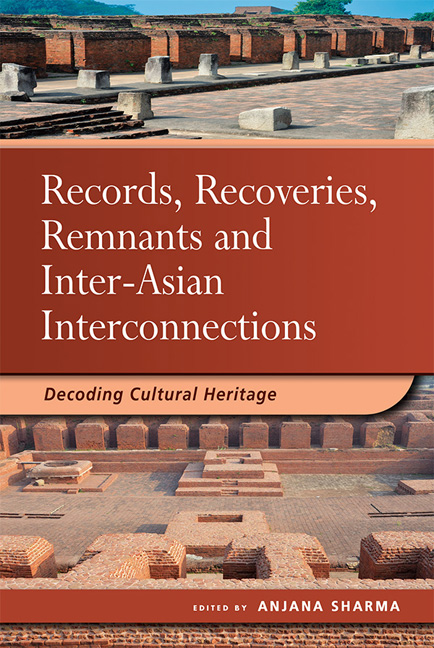Book contents
- Frontmatter
- Dedication
- Contents
- Contributors
- Acknowledgements
- 1 Introduction: Records, Recoveries, Remnants and Inter-Asian Interconnections — Decoding Cultural Heritage
- 2 Negotiating Place and Heritage: Creating Nalanda University
- 3 India, Magadha, Nalanda: Ecology and a Premodern World System
- 4 Collecting the Region: Configuring Bihar in the Space of Museums
- 5 Heritage Preservation in the Gaya Region
- 6 Setting the “Records” Straight: Textual Sources on Nālandā and Their Historical Value
- 7 “Central India Is What Is Called the Middle Kingdom”
- 8 The Object | The Tree: Emissaries of Buddhist Ground
- 9 Tracing Transregional Networks and Connections Across the Indic Manuscript Cultures of Nusantara (AD 1400–1600)
- 10 Seeking a Sufi Heritage in the Deccan
- 11 Archaeological Remains at Nalanda: A Spatial Comparison of Nineteenth Century Observations and the Protected World Heritage Site
- 12 A Heritage Gem Sits in the Heart of a City, Unacknowledged, Incognito: The Case for Recognizing Kolkata Chinatown as a Historic Urban Landscape
- Index
- Miscellaneous Endmatter
8 - The Object | The Tree: Emissaries of Buddhist Ground
Published online by Cambridge University Press: 04 July 2018
- Frontmatter
- Dedication
- Contents
- Contributors
- Acknowledgements
- 1 Introduction: Records, Recoveries, Remnants and Inter-Asian Interconnections — Decoding Cultural Heritage
- 2 Negotiating Place and Heritage: Creating Nalanda University
- 3 India, Magadha, Nalanda: Ecology and a Premodern World System
- 4 Collecting the Region: Configuring Bihar in the Space of Museums
- 5 Heritage Preservation in the Gaya Region
- 6 Setting the “Records” Straight: Textual Sources on Nālandā and Their Historical Value
- 7 “Central India Is What Is Called the Middle Kingdom”
- 8 The Object | The Tree: Emissaries of Buddhist Ground
- 9 Tracing Transregional Networks and Connections Across the Indic Manuscript Cultures of Nusantara (AD 1400–1600)
- 10 Seeking a Sufi Heritage in the Deccan
- 11 Archaeological Remains at Nalanda: A Spatial Comparison of Nineteenth Century Observations and the Protected World Heritage Site
- 12 A Heritage Gem Sits in the Heart of a City, Unacknowledged, Incognito: The Case for Recognizing Kolkata Chinatown as a Historic Urban Landscape
- Index
- Miscellaneous Endmatter
Summary
The story of the Buddha's enlightenment is one of complete transformation, of the world shaking, and of universal paradigms being broken. It was, in all senses of the word, cataclysmic. The story goes that after practising asceticism for many years, the Buddha ate some rice and milk before discerning a new path to liberation. Looking for a place to realize his new vision, the Buddha set his eyes on a small spot of ground below a pipal tree. He prepared his seat by laying a woven mat of grass and vowed never to rise before achieving total enlightenment. The climax of the dawn of enlightenment is when Mara, the God of Illusion, appears before Siddhartha demanding that he support his claim to defeat all delusion. In response, Siddhartha reaches his right hand down, touching the earth as witness to the magnitude of the merit of his acts up to that moment. The earth trembled and Siddhartha became a Buddha, realizing the truth of liberation from the cycle of death and rebirth.
There is something about the composition of ground, tree, and figure that creates a poignant scene for the great conflict of the Buddha's liberation. In many representations, the Buddha is shown serenely seated under a tree as demons attack, beautiful ladies tempt, and Mara provokes. In some depictions, the arching bows of the tree begin to trace a circle around the Buddha, defining an entire microcosm — a vision of reality or an ecosystem — that frames the moment of liberation. Like the transformation of the Sakya Prince into the Lord Buddha, the ground the Buddha sat upon and the tree he sat beneath were remade. The spot became the bodhimanda, or seat of enlightenment, and the tree the Buddha sat beneath became the bodhi tree, or tree of enlightenment. While both demand further consideration, this paper will focus on the bodhi tree as a liminal object between the figure of the Buddha and the ground of his enlightenment. It is, in fact, the tree's liminality that has made it an important living symbol of Buddhism. While iconographically rich with a history that extends from early depictions in the third century to countless iterations around the world, bodhi trees also occupy a central place in ritual engagements with Buddhism, especially around the making of sacred space and a modern history of Buddhism in India.
- Type
- Chapter
- Information
- Records, Recoveries, Remnants and Inter-Asian InterconnectionsDecoding Cultural Heritage, pp. 160 - 183Publisher: ISEAS–Yusof Ishak InstitutePrint publication year: 2018



